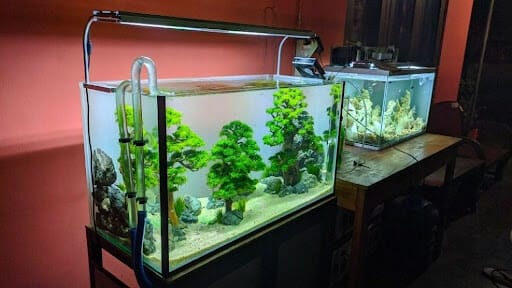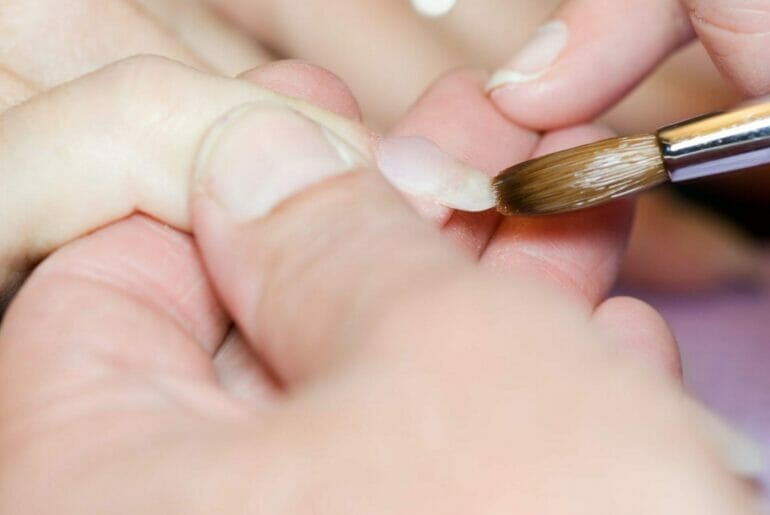Acrylic aquariums are known for their durability and longevity, making them a popular choice among fish enthusiasts. These tanks can last for decades when properly maintained and cared for.
Unlike glass aquariums, acrylic tanks are less prone to cracking or breaking and are more resistant to impacts. They also have better insulation properties, which helps maintain a stable water temperature.
With regular cleaning and maintenance, acrylic aquariums can provide a safe and beautiful habitat for your fish for many years. The lifespan of an acrylic aquarium ultimately depends on the quality of the tank, the care it receives, and any potential accidents or mishaps.

Maintenance Tips to Extend the Lifespan of Acrylic Aquariums
Acrylic aquariums are popular among fish enthusiasts due to their durability, clarity, and versatility. However, to ensure that your acrylic aquarium lasts for a long time and provides a healthy environment for your fish, proper maintenance is crucial. Here are some essential maintenance tips to help extend the lifespan of your acrylic aquarium:
1. Regular Cleaning
Regular cleaning is essential to keep your acrylic aquarium looking pristine and to maintain the health of your fish. Use a non-abrasive, acrylic-safe cleaner to wipe down the inside and outside surfaces of the aquarium. Avoid using harsh chemicals or abrasive sponges, as they can scratch or damage the acrylic.
It is also important to clean the gravel or substrate regularly to remove any debris or waste. Use a gravel vacuum to siphon out dirt and uneaten food particles that may have accumulated. Regular water changes are also essential to maintain water quality and remove any excess nutrients or pollutants.
2. Prevent Scratches
Acrylic aquariums are prone to scratches, so it is important to take precautions to prevent them. Avoid using abrasive materials or tools when cleaning the aquarium or removing algae. Instead, use a soft, non-abrasive cloth or sponge. When moving decorations or rearranging the tank, be careful not to scrape the acrylic against hard surfaces.
Consider placing a protective mat or pad under the aquarium to provide a cushioning layer and prevent scratches that may occur from the tank’s weight or movement.
3. Avoid Direct Sunlight
Direct sunlight can cause unwanted algae growth and lead to temperature fluctuations in the aquarium. Position your acrylic aquarium away from windows or areas with direct sunlight to minimize these issues. If necessary, use a light-blocking curtain or shade to prevent sunlight from reaching the tank.
4. Monitor Water Parameters
Regularly monitor and maintain the water parameters in your acrylic aquarium to ensure a healthy environment for your fish. Test the water regularly for pH, ammonia, nitrite, and nitrate levels. Make necessary adjustments to maintain optimal levels and address any issues promptly.
Invest in a reliable water testing kit and follow the recommended guidelines for each parameter. This will help prevent problems such as poor water quality, stress, and diseases in your fish.
5. Be Mindful of Temperature
Acrylic aquariums are more prone to temperature fluctuations compared to glass tanks. It is important to maintain a stable temperature within the aquarium to ensure the well-being of your fish. Use a reliable heater and thermometer to monitor and regulate the water temperature.
Avoid placing the aquarium near drafts, vents, or other sources of temperature variations. Sudden temperature changes can stress or even harm your fish.
6. Handle with Care
When moving or handling your acrylic aquarium, always exercise caution to avoid accidents or damage. Acrylic is lightweight, but it can still crack or break under certain circumstances. Lift the aquarium from the bottom or use a sturdy support to avoid applying excessive pressure on the walls.
If you need to transport the aquarium, empty it of water, decorations, and fish. Secure the lid tightly to prevent any leaks or spills during transportation.
7. Regular Maintenance Schedule
Establish a regular maintenance schedule for your acrylic aquarium to ensure consistent care. This should include tasks such as cleaning the tank, checking and maintaining equipment, monitoring water parameters, and performing regular water changes.
By following a routine maintenance schedule, you can stay on top of any issues or potential problems and address them promptly, prolonging the lifespan of your acrylic aquarium.
Summary
Proper maintenance is essential to extend the lifespan of acrylic aquariums. Regular cleaning, preventing scratches, avoiding direct sunlight, monitoring water parameters, maintaining stable temperatures, handling with care, and following a regular maintenance schedule are key to keeping your acrylic aquarium in top condition. By following these tips, you can enjoy a beautiful and healthy aquatic environment for years to come.

Sign of Aging in Acrylic Aquariums and How to Address Them
Acrylic aquariums are a popular choice for many fish enthusiasts due to their durability, clarity, and versatility. However, like any other material, acrylic can show signs of aging over time. In this section, we will explore the common signs of aging in acrylic aquariums and discuss effective ways to address them.
1. Scratches
One of the most common signs of aging in acrylic aquariums is the presence of scratches on the surface. Scratches can occur due to various reasons, such as improper cleaning techniques or contact with rough objects. These scratches not only affect the aesthetic appeal of the aquarium but can also create hiding spots for harmful bacteria and algae.
To address scratches on your acrylic aquarium, you can start by using a specialized acrylic scratch remover. These products are designed to gently polish the surface and minimize the appearance of scratches. It is important to follow the instructions provided by the manufacturer and avoid using abrasive materials that could further damage the acrylic.
2. Yellowing
Over time, acrylic aquariums may develop a yellowish tint, which can diminish the clarity and beauty of the tank. The yellowing is typically caused by exposure to UV light and certain cleaning chemicals. Additionally, improper maintenance and the buildup of algae can contribute to the discoloration.
To address yellowing in acrylic aquariums, you can take several steps. Firstly, ensure that your aquarium is not placed in direct sunlight or close to any UV light sources. Regular maintenance, including proper cleaning and water changes, can also help prevent the buildup of algae and other substances that contribute to yellowing. Using a specialized acrylic cleaner can further aid in restoring the clarity of the acrylic.
3. Crazing
Crazing refers to the development of fine, spiderweb-like cracks on the surface of the acrylic. This can occur due to excessive stress or pressure on the material, temperature fluctuations, or improper handling. Crazing not only affects the appearance of the aquarium but can also weaken the structural integrity of the acrylic.
If you notice crazing in your acrylic aquarium, it is crucial to address it promptly to prevent further damage. In some cases, minor crazing can be repaired using acrylic repair kits that are readily available in the market. However, if the damage is extensive or poses a risk to the structural stability of the aquarium, it may be necessary to consider replacing the affected panels or the entire aquarium.
4. Warping
Acrylic can gradually warp over time, resulting in uneven surfaces or distorted shapes in the aquarium. Warping can be caused by exposure to excessive heat, improper installation, or proximity to high-power equipment that generates heat. This can affect the overall aesthetic appeal of the aquarium and cause issues with water circulation.
To address warping, it is important to ensure proper installation and avoid exposing the acrylic aquarium to extreme temperatures. If warping occurs, it may be necessary to replace the affected panels or the entire aquarium to restore its original shape and functionality.
5. Leaks
As acrylic aquariums age, there is a possibility of developing leaks or cracks that can lead to water damage and potential harm to the aquatic life. Leaks can occur due to material fatigue, inadequate sealing, or physical damage to the acrylic. Regular inspection and maintenance are essential to detect and address leaks in a timely manner.
If you discover a leak in your acrylic aquarium, it is crucial to act quickly to prevent further damage. Depending on the size and location of the leak, you may be able to repair it using specialized acrylic adhesives or sealants. However, in severe cases, it may be necessary to replace the affected panels or the entire aquarium to ensure the safety of your aquatic pets.
Summary
Acrylic aquariums, while known for their durability, can show signs of aging over time. Scratches, yellowing, crazing, warping, and leaks are common issues that may arise in acrylic aquariums. However, with proper care and maintenance, these signs of aging can be addressed effectively. By using specialized products, following appropriate cleaning techniques, and conducting regular inspections, you can maintain the beauty and functionality of your acrylic aquarium for years to come.

Comparing the Lifespan of Acrylic and Glass Aquariums
When it comes to choosing an aquarium for your fish, one of the key factors to consider is the lifespan of the aquarium itself. Two popular options on the market are acrylic and glass aquariums. In this section, we will compare the lifespan of these two types of aquariums and discuss their pros and cons.
1. Acrylic Aquariums
Acrylic aquariums are made from a type of plastic that is known for its durability and strength. They are often preferred by fish enthusiasts due to their lightweight nature and impact resistance. But how long can you expect an acrylic aquarium to last?
On average, an acrylic aquarium can last anywhere from 10 to 20 years. However, with proper care and maintenance, some acrylic aquariums have been known to last even longer. The key to prolonging the lifespan of an acrylic aquarium is to avoid scratching the surface and to prevent exposure to sharp objects or abrasive cleaning materials.
One of the advantages of acrylic aquariums is their resistance to impact. Unlike glass aquariums, which are more prone to cracking or shattering if dropped or impacted, acrylic aquariums are highly durable and less likely to break. This makes them a safer option, especially in households with children or pets.
Another benefit of acrylic aquariums is their versatility in design. Acrylic is a highly moldable material, allowing for the creation of unique shapes and curves that are not possible with glass. This can enhance the aesthetic appeal of your aquarium and create a visually stunning focal point in any room.
2. Glass Aquariums
Glass aquariums have been a staple in the fishkeeping hobby for many years. They are known for their clarity and scratch resistance. But how does the lifespan of a glass aquarium compare to that of an acrylic one?
A well-maintained glass aquarium can last for decades. With proper care and regular cleanings, it is not uncommon for a glass aquarium to surpass the 20-year mark. Glass has excellent scratch resistance, which means you don’t have to worry about minor surface scratches affecting the overall lifespan of the aquarium.
One of the main advantages of glass aquariums is their optical clarity. Glass offers a crystal-clear view of your fish and their surroundings, allowing for a more immersive viewing experience. This optical clarity is especially important for avid hobbyists who are passionate about observing the intricate details of their aquatic pets.
However, glass aquariums are more susceptible to impact damage compared to acrylic. Dropping or mishandling a glass aquarium can result in cracks or even shattered panels. Therefore, it is crucial to handle glass aquariums with care and avoid placing them in high-traffic areas where accidental bumps or knocks may occur.
In summary, both acrylic and glass aquariums have their own set of advantages and disadvantages when it comes to lifespan. Acrylic aquariums, with their impact resistance and unique design possibilities, can last up to 10 to 20 years or even longer with proper care. On the other hand, glass aquariums offer excellent optical clarity and can last for decades if well-maintained and handled with care.
Ultimately, the choice between acrylic and glass aquariums depends on your specific needs and preferences. Consider factors such as durability, design options, and safety when selecting the perfect aquarium for your aquatic companions. With proper care and maintenance, both types of aquariums can provide a beautiful and thriving environment for your fish for years to come.
Upgrading and Replacing Acrylic Aquariums: When is the Right Time?
Acrylic aquariums have become increasingly popular among hobbyists due to their lightweight, durability, and clarity. However, just like any other equipment, they have a limited lifespan and may require upgrading or replacement at some point. In this section, we will discuss when is the right time to consider upgrading or replacing your acrylic aquarium.
1. Physical Damage
One of the main reasons to upgrade or replace your acrylic aquarium is physical damage. Over time, acrylic can develop scratches, cracks, or other forms of damage that can affect the overall appearance and functionality of the tank. While minor scratches can often be buffed out, extensive or deep damage may warrant an upgrade or replacement.
Additionally, if you notice any structural cracks or leaks in your acrylic aquarium, it is crucial to take immediate action. Cracks can compromise the integrity of the tank and pose a risk to both the aquatic life and your home. In such cases, upgrading or replacing the aquarium is the best course of action to prevent potential disasters.
2. Size Limitations
Another factor to consider when deciding whether to upgrade or replace your acrylic aquarium is size limitations. As your expertise and passion for the hobby grow, you may find yourself wanting to keep larger fish species or increase the number of inhabitants in your tank. However, if your current aquarium is too small to accommodate your desired setup, it may be time to upgrade to a larger size.
Acrylic aquariums come in various sizes, and upgrading to a bigger tank can provide more space for your aquatic pets to thrive. Keep in mind that larger tanks also require appropriate filtration and maintenance, so ensure you have the necessary resources and knowledge to care for a larger setup.
3. Technological Advancements
The aquarium industry is constantly evolving, with new technological advancements and features being introduced regularly. If you find that your current acrylic aquarium lacks the latest features or equipment that can enhance the living conditions for your aquatic pets, it may be worth considering an upgrade.
For example, newer models of acrylic aquariums often come with improved filtration systems, energy-efficient lighting, automated feeding mechanisms, and integrated monitoring systems. These advancements can not only enhance the aesthetics of your tank but also make maintenance tasks more convenient and efficient.
4. Aesthetic Preferences
Over time, your aesthetic preferences for your aquarium may change. What once appealed to you may no longer align with your current taste or interior design theme. If you find yourself no longer satisfied with the look of your acrylic tank, it might be a good idea to consider replacing it with a different style or design.
Upgrading to a tank with a different shape, color, or background can breathe new life into your aquarium and reignite your passion for the hobby. However, always ensure that the new tank meets the necessary requirements for the fish and plants you plan to keep.
5. Maintenance Challenges
Lastly, maintenance challenges can also influence the decision to upgrade or replace your acrylic aquarium. If you find that your current tank requires frequent and complicated maintenance routines, it may be worth considering a more user-friendly option.
Newer acrylic aquarium models often come with features such as easy-access filtration systems, integrated cleaning mechanisms, and self-regulating water parameters. These advancements can significantly simplify the maintenance process, making it more enjoyable and less time-consuming for hobbyists.
In summary, the right time to upgrade or replace your acrylic aquarium depends on various factors such as physical damage, size limitations, technological advancements, aesthetic preferences, and maintenance challenges. Assessing these aspects will help you make an informed decision and ensure a thriving and visually appealing aquatic environment for your beloved pets.
FAQs
How long do acrylic aquariums last?
Acrylic aquariums can last for several decades if they are properly cared for. With regular maintenance and proper cleaning techniques, acrylic tanks can remain in good condition for 20-30 years or even longer.
Conclusion
In conclusion, acrylic aquariums offer a durable and long-lasting option for fish enthusiasts. With proper care and maintenance, acrylic aquariums can last for many years, providing a stunning and clear view of your underwater world.
Acrylic material is known for its strength and resilience, making it less prone to cracks and damage compared to glass aquariums. This means you can enjoy the beauty of your fish and aquatic plants without worrying about the longevity of your aquarium.
Furthermore, advances in acrylic technology have resulted in improved UV resistance and reduced yellowing over time. This ensures that your acrylic aquarium remains crystal clear and aesthetically pleasing for an extended period.
Investing in an acrylic aquarium is a wise choice for both beginners and experienced aquarists, as it guarantees a sturdy and long-lasting aquatic habitat for your beloved fish.
